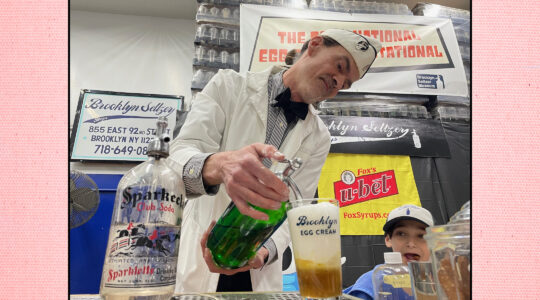It’s been a long time coming, but the evidence is beginning to mount: Israeli wines are making their mark. Exports from Israel to the U.S. and global markets are up, sales are seen as “very strong” and the tastemakers of the wine world are taking note and giving high marks to Israeli vintages.
“Israeli wines remain an incredibly strong growth area in the kosher wine world,” says Jay Buchsbaum, vice president of marketing and director of wine education with the Royal Wine Corp., the largest producer, importer and distributor of kosher wines and spirits with 27 different Israeli wineries in its portfolio.
“Israel is definitely an incredibly popular part of the market,” agrees Shai Ghermezian, executive vice president of Allied Importers, the No. 2 importer and distributor of kosher wines in the U.S.
“While some brands are steady performers,” says Buchsbaum, “others seem to fly off the shelf. … Some of the wineries can’t produce anything like enough volume to satisfy U.S. demand.”
Mendel Ungar of New York’s Red Garden Imports, which includes nine different Israeli wineries in its growing portfolio, notes that since roughly “the time of the second Iraq war [2003], when French wines fell out of favor due to politics, Israeli wines have been gaining ground in the U.S. kosher wine market, and since then it’s gone up, more and more — sales are very strong today. Something like 70-80 percent of the kosher wine market here is Israeli wine. In the last couple of years, European wines have come back quite nicely, with a big jump last year in particular, but Israeli wines are very strong, and I think their position in the market is going to hold strong.”
According to recent figures from the Israel Export and International Cooperation Institute, in 2015 Israel’s wine exports to North America — its largest single export market — grew 8 percent to $25 million. To put this in context, global export of Israeli wines grew 6 percent to $39 million, according to the institute’s figures.
So what’s driving all this growth? Why are Israeli wines so popular among American kosher wine consumers?
According to Ghermezian, part of the answer is that “the overall quality and vitality of Israeli wines is really good, and the general perception in the market is that they are getting better every year and representing generally good value.” Similarly, says Buchsbaum, “not only is the quality of Israeli wines consistently high, but the critical reception of Israeli wines also gets better every year.”
The El Rom Vineyard in the Golan Heights. Courtesy of Golan Heights Winery
Josh Greenstein, of the Royal Wine Corp.-backed Israeli Wine Producers Association adds, “Israeli wine is now being acknowledged, even lauded, for its successes.” More than “50 Israeli wines,” he notes, “have been awarded 90+ scores by such renowned industry experts and critics as Robert Parker’s The Wine Advocate, and by Wine Spectator and Wine Enthusiast magazines.” These wines are not, he observes, “being recognized as great kosher wines or as great for Israeli wine, but as great wines amidst the world’s variety of great wines.”
Adam Montefiore, the wine development director of the Carmel Winery, Israel’s largest wine producer, also points to the quality factor: “I believe that Israel is making the best kosher wines, and the best variety of kosher wines, in the world today. Even people who don’t agree should acknowledge that we offer the best variety of kosher wines.”
After all, he adds, “It’s a country with so much variety; it’s a long thin country, like Italy in a way, and we have an enormous amount of different micro-climates. Just to give you an example, the harvest in California or France is two months, but in Israel it lasts from July until maybe the first week in November. Different ripening times. And every wine is a learning curve. Every wine is experimenting. Every winery is planting new varieties. It’s like we’re surfing a wave.”
Amid all the laudatory comments, Victor Schoenfeld, head winemaker of the Golan Heights Winery (GHW), Israel’s third-largest producer, injects a caveat:
“To flourish long-term,” he says, “the Israeli wine industry must produce a critical mass of high-quality wines that can be exported around the world. While Israel’s reputation as a quality wine producer is ever increasing, we must continue to think long-term and work toward improving the quality and reputation of Israeli wines.”
Schoenfeld has long argued that there is “no cost benefit” for Israel “to compete in the lower end of the market; that is a dead end for Israeli wines — see the ongoing uprooting of vines in lower-quality areas of Australia and the Central Valley of California.” Rather, he maintains, Israeli wine “must concentrate on high-end wines unique to where we are.” For the GHW, for example, he knows of “no other area that combines our latitude with high-altitude volcanic soils,” so GHW’s “goal is to produce wines that reflect this unique — and the more we learn the more we understand just how fantastic — terroir.”
One of the ways GHW is striving to accomplish this is through constant improvements and upgrades. In 2009, for example, in response to leafroll virus in the vineyards (“a huge problem in Israel”), notes Schoenfeld, GHW “really understood the extent of the problem” and knew that “a large wave of planting” was in order, so it decided to “leverage the problem” or “exploit the opportunity” to “improve our vineyards.” To this end, he explains that GHW “started a huge project of upgrading our vineyards,” and it also became “licensed for vine propagation and vine nursery by Entav,” the world leader in wine vine propagation. Through this propagation facility, “Israeli producers are now able to purchase some of the highest quality vine material — meaning vines to plant — available in the world today.”
That same year, Schoenfeld adds, GHW also “fundamentally changed” how it “plans out new vineyards and how we grow them in the years leading up to their first harvest.” Further, in 2013 it “replaced hand-sorting of fruit in the winery with optical sorting, which has caused a quantum jump in both the volume and quality of our sorting.” As Schoenfeld makes clear, GHW is “always thinking how to upgrade what we do.”
Of course, quality is not the only factor in the consistent and growing popularity of Israeli wines in the U.S. Another, suggests Mendel Ungar, is the general style of the wines. A lot of Israeli wine, he maintains, is robustly flavored, rather than restrained or subtle; it’s more New World than Old World — “more like California wines than like French wines.”
Red Garden’s portfolio has a lot of European wines, he’s quick to note, and the French wines it imports are more elegant, subtle and refined. “In Yiddish we’d say they were aydel” [genteel, refined]. Israeli wines, he notes, are more broad, full-flavored and extroverted — “in Hebrew it’s called ‘bombasti.’ People who drink Israeli wine expect the wine to have a first impression of extreme and big flavors. … Many, if not most, Israeli wines are made this way,” and it’s clearly a popular style.
Sentimentality and Jewish communal identity are also factors in the ongoing popularity of Israeli wines. “A lot of kosher wine consumers,” notes Shai Ghermezian, “want to support Israel anyway, so if they are already willing to spend a few extra dollars on a good wine, they’ll seek an Israeli wine. The fact that Israel makes such great wines simply makes this choice an easy one.”
Red Garden’s Ungar concurs: “It is definitely easier to sell an expensive Israeli wine, than any other [expensive] non-Israeli wine. Once people are spending $50 or $60, many want to spend it on Israel.” They might normally drink French or Spanish wines in the average price range, he says, “but when it comes to spending real money, many prefer that it should be on an Israeli bottle of wine. It’s unbelievable the number of expensive Israeli wines being sold here.”
In all this growth, there are also some clear trends. “There is a clear trend for high-end mevushal wines,” notes Allied’s Shai Ghermezian. “The Cave was the first major Israeli high-end wine to offer mevushal,” he says, “but Shiloh came in with a wider range and consistent high quality, followed by Psagot. Others are now really following their lead. Dalton’s recent mevushal Alma, for example, has been very successful.”
Ruti Schvarcz of Happy Hearts Wines, which has 10 different highly regarded Israeli wine brands in its portfolio, fully agrees: “Yes, 100 percent, mevushal high-end Israeli wines are in demand. We used to have [in our portfolio] the lower-level mevushalim, in most cases, but we’ve completely reversed on that because we came to realize that kosher restaurants with serious wine are eager for and really looking for higher-end mevushal Israeli wines. This pressure from American kosher restaurants and caterers is really driving it.”
Still, she notes, “the wineries are not so eager to do it, and some are even afraid of it — these are their high-end wines after all and they don’t want to risk damaging their reputations, but the economic benefits today are clear and compelling.”
While according to Gil Shatsberg, head winemaker at the Recanati Winery, one of Israel’s 10 largest producers, the high-end mevushal issue is a “very touchy” subject.
“We know the commercial potential of making a high-end mevushal wine,” he explains, “but thus far we are refraining from doing this — mainly from an enological point of view.” The bottom line is the potential damage to a wine’s reputation: “Making a wine mevushal has the potential to shorten a wine’s lifespan and we don’t want a ‘Reserve’ or ‘Special Reserve’ label to disappoint down the road — it could happen.”
When pressed about the potential effects of the mevushal process, Shatsberg made clear that this thinking is based largely on “conventional wisdom” and is more “of an educated guess” than empirical certainty, but the “risks” are considered too “real.”
Ghermezian also points to “huge interest and growth” in Israeli rosé wines, though he imagines the Shmita issue will “hinder availability” a bit as those wines won’t likely see the U.S. market.
Interestingly, notes Shatsberg, Recanati has very recently decided to sell its Shmita wines in the U.S. “From talking with kosher wine retailers in the U.S., we got a clear sense that they consider kosher consumers much more educated and aware about Shmita, and so are able to avoid mistakes … so we are going to export Shmita wines. We are handling it cautiously; the wines will have different barcodes from our regular wines, and it will be clear to anyone who buys them that they are buying a Shmita year, which is a big deal.
“One of our new wines that will hit the U.S. in limited quantities in time for Passover is our Recanati Gris de Marselan rosé 2015, it is a Shmita year, but it will be coming. … Most of the wine stores that primarily serve the Orthodox communities, like in Brooklyn, Monsey and the like, will not take it, but wine stores that are mixed, kosher and non-kosher, and many outside of New York will take them. It is made from a bleeding of the Marselan grapes; it turned out very nice. It’ll be released in small amounts, because we don’t want to take big risks because it’s Shmita. For those stores who won’t handle Shmita wines, we had set aside huge amounts of the 2014 vintage—so no accounts will have to forgo Recanati wines.”
Although 2015 was a difficult vintage, says Shatsberg, “it was a very good year for certain varietals — if you harvested early enough; we had a very severe heat spell towards the end of the season, so people who waited suffered some shriveling and burning of the fruit from scorching sun, so it was difficult, but overall the quality was good.”
“The well-known Israeli brands are having an easier time of it, and the price points make a significant difference, but all in all,” says Shai Ghermezian, “Israeli wines are still hot, and everyone under the sun in the kosher wine market wants Israeli wines.” ♦
The New York Jewish Week brings you the stories behind the headlines, keeping you connected to Jewish life in New York. Help sustain the reporting you trust by donating today.




